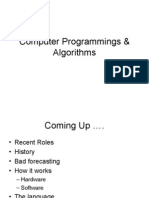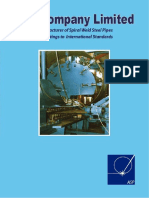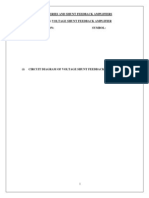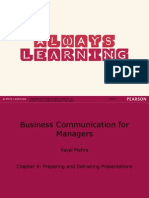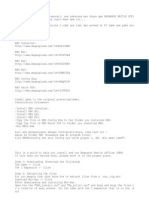Computer Languages
Computer Languages
Uploaded by
hamza abbasCopyright:
Available Formats
Computer Languages
Computer Languages
Uploaded by
hamza abbasOriginal Title
Copyright
Available Formats
Share this document
Did you find this document useful?
Is this content inappropriate?
Copyright:
Available Formats
Computer Languages
Computer Languages
Uploaded by
hamza abbasCopyright:
Available Formats
Lecture 03: Introduction CS 101: Introduction to Computing
Computer Languages
• Three types of programming languages
1. Machine languages
• Strings of numbers giving machine specific instructions
• Example:
10001010
00100010
11100011
2. Assembly languages
• English-like abbreviations representing elementary
computer operations (translated via assemblers)
• Example:
LOAD BASEPAY
ADD OVERPAY
STORE GROSSPAY
Ghulam Ishaq Khan Institute of Engineering Sciences and Technology, Topi
Lecture 03: Introduction CS 101: Introduction to Computing
Computer Languages
1. High-level languages
• Similar to everyday English, use mathematical notations
(translated via compilers)
• Example:
grossPay = basePay + overTimePay
• C/C++ is a High-level language.
Ghulam Ishaq Khan Institute of Engineering Sciences and Technology, Topi
Lecture 03: Introduction CS 101: Introduction to Computing
Types of Computing
• Personal computers
– First PC introduced by IBM in 1981
– Economical enough for individual
• Distributed computing
– Computing distributed over networks
– Often used LANs
– PCs were powerful enough to
• handle the computing requirements of individual users
• handle the basic communication tasks/information passing between the PCs
electronically
• Client/server computing
– Sharing of information across computer networks between file servers
and clients (personal computers)
Ghulam Ishaq Khan Institute of Engineering Sciences and Technology, Topi
Lecture 03: Introduction CS 101: Introduction to Computing
Types of Computing
• Parallel Computing
– Used to solve large and complex problems
– Goal?
• Divide problem into sub-problems
• Use multiple processors to solve each of the
individual problem
• Combine the results of the individual sub-problem
to generate the solution of the original complex
problem
Ghulam Ishaq Khan Institute of Engineering Sciences and Technology, Topi
Lecture 03: Introduction CS 101: Introduction to Computing
Computer Hardware
Ghulam Ishaq Khan Institute of Engineering Sciences and Technology, Topi
Lecture 03: Introduction CS 101: Introduction to Computing
Computer Chips (-1-)
• Most electronic components inside a computer are
integrated circuits
– Thin slices of silicon crystal packed with microscopic circuit
elements
• Semiconducting materials are
used to fabricate a chip
• Types of chips:
– DIPs; DIMMs; PGAs;
SEC cartridge
• *The motherboard houses all essential chips and
provides connecting circuitry between them
Ghulam Ishaq Khan Institute of Engineering Sciences and Technology, Topi
Lecture 03: Introduction CS 101: Introduction to Computing
Computer Chips (-2-)
Dual
Dual In-line
In-line Memory
Package Module
(DIP) (DIMM)
Pin Single
Grid Edge
Array Contact
(PGA) (SEC)
Ghulam Ishaq Khan Institute of Engineering Sciences and Technology, Topi
Lecture 03: Introduction CS 101: Introduction to Computing
Microprocessor
• An integrated circuit designed to process instructions -
CPU on a chip
• The CPU has two parts
– ALU (arithmetic logic unit)
• Performs arithmetic operations
• Performs logical operations
• Uses registers to hold data being
processed
– Control Unit
• Directs and coordinates processing
Ghulam Ishaq Khan Institute of Engineering Sciences and Technology, Topi
You might also like
- FA0996 - (2021.08.02) Mini PackDocument33 pagesFA0996 - (2021.08.02) Mini PackOratexaNo ratings yet
- Unit-1 Python Notes PDFDocument50 pagesUnit-1 Python Notes PDFmichaelmathuNo ratings yet
- M1 Part1 NotesDocument22 pagesM1 Part1 Notessureshyvsoori100% (1)
- Komatsu Parts Numbering System: Call The ExpertsDocument30 pagesKomatsu Parts Numbering System: Call The ExpertsChristian Moreno100% (1)
- Part-3 Uber BillDocument16 pagesPart-3 Uber BillgeorgeNo ratings yet
- Manuale 24kv tpr6 24 - Globale - Ed04-LightDocument92 pagesManuale 24kv tpr6 24 - Globale - Ed04-LightJulio A Manzini ColinaNo ratings yet
- Introduction To Computing Systems:: From Bits and Gates To C and BeyondDocument15 pagesIntroduction To Computing Systems:: From Bits and Gates To C and BeyondNirmal GuptaNo ratings yet
- Tightening Procedure For Tie Rod PDFDocument6 pagesTightening Procedure For Tie Rod PDFLenine DmonteiroNo ratings yet
- Computer LanguagesDocument8 pagesComputer Languageshamza abbasNo ratings yet
- ITC Lect 03 (Computer Hardware)Document15 pagesITC Lect 03 (Computer Hardware)Muhammad Faizan KhanNo ratings yet
- Data Representation: Zawar HussainDocument11 pagesData Representation: Zawar HussainMuqadas HussainNo ratings yet
- Introduction To Computer OrganizationDocument17 pagesIntroduction To Computer OrganizationBijay MishraNo ratings yet
- Heaven's Light Is Our GuideDocument23 pagesHeaven's Light Is Our Guideturzo8835No ratings yet
- Lecture 1 (Computer Fundamental)Document23 pagesLecture 1 (Computer Fundamental)thehonouredone666No ratings yet
- ITC Lect 02 (Computer Components AI) - REVISEDDocument49 pagesITC Lect 02 (Computer Components AI) - REVISEDMuhammad Faizan KhanNo ratings yet
- CMPS161ClassNotesChap01 PDFDocument15 pagesCMPS161ClassNotesChap01 PDFSky Angel100% (1)
- Chapter 1 PDFDocument94 pagesChapter 1 PDFRiyaz ShaikNo ratings yet
- ITC Lect 02 (Computer Components)Document32 pagesITC Lect 02 (Computer Components)komega173No ratings yet
- Introduction To Computers, Programs, and Java: Servers, Desktop Computers, and Small Hand-Held DevicesDocument18 pagesIntroduction To Computers, Programs, and Java: Servers, Desktop Computers, and Small Hand-Held DevicesKartik SharmaNo ratings yet
- Parts of A Computer: Zawar HussainDocument21 pagesParts of A Computer: Zawar HussainMuqadas HussainNo ratings yet
- Chapter 1 COALDocument46 pagesChapter 1 COALShahzael MughalNo ratings yet
- Introduction To Computing (CS-141) : Engr. Ehtasham Naseer EE Department QCETDocument23 pagesIntroduction To Computing (CS-141) : Engr. Ehtasham Naseer EE Department QCETEhtasham Naseer ChauhdryNo ratings yet
- Introduction To ComputerDocument50 pagesIntroduction To Computerkyl1997smksNo ratings yet
- C++Lecture 1 Intro To ComputersDocument32 pagesC++Lecture 1 Intro To ComputersAlili AmarNo ratings yet
- High Performance Computing: Course IntroductionDocument32 pagesHigh Performance Computing: Course Introductionmmit123No ratings yet
- Complete Assignment of Computer ArchitectureDocument5 pagesComplete Assignment of Computer ArchitectureSakar KhatriNo ratings yet
- Week2 Lecture 02Document48 pagesWeek2 Lecture 02numl-s23-15504No ratings yet
- Unit 1Document67 pagesUnit 1AgateNo ratings yet
- L01_IntroDocument70 pagesL01_IntrohhunggNo ratings yet
- POP Module-1 NotesDocument66 pagesPOP Module-1 NotessharanabasupolicepatilNo ratings yet
- Notes For CAE-1 - All TopicsDocument60 pagesNotes For CAE-1 - All Topicsplantforest16No ratings yet
- CH 01Document28 pagesCH 01Tran Nguyen KhangNo ratings yet
- CDA L1Document57 pagesCDA L1ibrahimmaulid551No ratings yet
- Computer GenerationsDocument17 pagesComputer Generationsjenefer cabinganNo ratings yet
- Chapter 1 BCPDocument49 pagesChapter 1 BCPDej AynNo ratings yet
- 2.introduction To Parallel ProcessingDocument53 pages2.introduction To Parallel ProcessingKeshav LamichhaneNo ratings yet
- Unit 1 PDFDocument59 pagesUnit 1 PDFTanmay WalkeNo ratings yet
- EE 271 Digital Circuits and Systems: Course Specification (Syllabus)Document41 pagesEE 271 Digital Circuits and Systems: Course Specification (Syllabus)R.R.S. SavichevaNo ratings yet
- Microprocessor Fundamentals: by Physics Department Smt. CHM College, Ulhasanagar-3Document26 pagesMicroprocessor Fundamentals: by Physics Department Smt. CHM College, Ulhasanagar-3Prof. Yashavant p. Jadhav100% (1)
- 526 ReviewerDocument3 pages526 ReviewermatthewivanNo ratings yet
- Fundamental of Computer PDFDocument30 pagesFundamental of Computer PDFVanlalchhanchhuahaNo ratings yet
- Computer Organization ArchitecturekDocument97 pagesComputer Organization ArchitecturekAnoze UsmanNo ratings yet
- Computer Organization and Architecture by William StallingDocument34 pagesComputer Organization and Architecture by William StallingFinding_Nemo4No ratings yet
- IT Application Tools in BusinessDocument4 pagesIT Application Tools in BusinessaaronjusayannNo ratings yet
- Chap 01Document11 pagesChap 01Zerihun BekeleNo ratings yet
- Chapter 1 Introduction To ComputersDocument13 pagesChapter 1 Introduction To ComputersMuli AnalystNo ratings yet
- CS6461 - Computer Architecture Fall 2016 Morris Lancaster: Lecture 3 - Instruction Set ArchitectureDocument40 pagesCS6461 - Computer Architecture Fall 2016 Morris Lancaster: Lecture 3 - Instruction Set Architecture闫麟阁No ratings yet
- Bai Cfo - 102 - Unit 1Document35 pagesBai Cfo - 102 - Unit 1Aman SinghNo ratings yet
- Computer Architecture NCS-505Document55 pagesComputer Architecture NCS-505PrachiNo ratings yet
- Computer Programmings & AlgorithmsDocument32 pagesComputer Programmings & AlgorithmsAdons ChuitraNo ratings yet
- PSUCDocument337 pagesPSUCshuklashreyanshuNo ratings yet
- Unit - 1 (4) - 2-20 - MergedDocument20 pagesUnit - 1 (4) - 2-20 - Mergedprasoonkingrewa2No ratings yet
- Parallel ComputingDocument32 pagesParallel ComputingKhushal BisaniNo ratings yet
- An Introduction To Computers: Definition of Computer System Components of Computer System Evolution of ComputersDocument53 pagesAn Introduction To Computers: Definition of Computer System Components of Computer System Evolution of Computersmohsin66No ratings yet
- Introduction To ComputersDocument71 pagesIntroduction To ComputersHubert EnzooNo ratings yet
- Von Neuman Machine Lec 22Document27 pagesVon Neuman Machine Lec 22Musa NabeelNo ratings yet
- Input/Output: The Computer's Response Time Is No Match For OursDocument108 pagesInput/Output: The Computer's Response Time Is No Match For OursPrashantJoshiNo ratings yet
- Unit4 Session2 Parallel Computing ClassificationDocument15 pagesUnit4 Session2 Parallel Computing ClassificationbhavanabadayNo ratings yet
- Dpco Notes All UnitsDocument155 pagesDpco Notes All UnitsKugan SparrowNo ratings yet
- Computer: Shivam SharmaDocument22 pagesComputer: Shivam Sharmasharma_shivam100% (1)
- Topic 1Document32 pagesTopic 1Rosan OjhaNo ratings yet
- Programming Language II: Lecturer: Professor Dr. M. MonessDocument29 pagesProgramming Language II: Lecturer: Professor Dr. M. MonessAnonymous 2h5lIeNo ratings yet
- ES1 REVIEWER SummarizedDocument4 pagesES1 REVIEWER SummarizedMontes Arianne A.No ratings yet
- Computer Basics File ManagementDocument29 pagesComputer Basics File ManagementFiratNo ratings yet
- PLC: Programmable Logic Controller – Arktika.: EXPERIMENTAL PRODUCT BASED ON CPLD.From EverandPLC: Programmable Logic Controller – Arktika.: EXPERIMENTAL PRODUCT BASED ON CPLD.No ratings yet
- General Chemical Safety & Handling of Chemicals in LabsDocument29 pagesGeneral Chemical Safety & Handling of Chemicals in Labshamza abbasNo ratings yet
- Accident InvestigationDocument15 pagesAccident Investigationhamza abbasNo ratings yet
- Promoting A Positive Health and Safety Culture PDFDocument31 pagesPromoting A Positive Health and Safety Culture PDFhamza abbasNo ratings yet
- Gik Institute of Engineering Sciences & Technology Faculty of Engineering SciencesDocument1 pageGik Institute of Engineering Sciences & Technology Faculty of Engineering Scienceshamza abbasNo ratings yet
- Guidance On Command WordsDocument67 pagesGuidance On Command Wordshamza abbasNo ratings yet
- Cs 101Document29 pagesCs 101hamza abbasNo ratings yet
- General Chemical Safety & Handling of Chemicals in Labs: Edited Version Dr. Khurram Imran Khan GIK Institute, TopiDocument30 pagesGeneral Chemical Safety & Handling of Chemicals in Labs: Edited Version Dr. Khurram Imran Khan GIK Institute, Topihamza abbasNo ratings yet
- Switch Control Structure: Lecture #13Document8 pagesSwitch Control Structure: Lecture #13hamza abbasNo ratings yet
- CS 101-Introductinon To Computing: Zawar HussainDocument16 pagesCS 101-Introductinon To Computing: Zawar Hussainhamza abbasNo ratings yet
- If/else Control Structure: Lecture #9Document14 pagesIf/else Control Structure: Lecture #9hamza abbasNo ratings yet
- Lecture #10: While LoopDocument6 pagesLecture #10: While Loophamza abbasNo ratings yet
- Outline: CommentsDocument5 pagesOutline: Commentshamza abbasNo ratings yet
- Logical Flow of A Program: Algorithms, Flowcharts, PseudocodeDocument22 pagesLogical Flow of A Program: Algorithms, Flowcharts, Pseudocodehamza abbasNo ratings yet
- Hardware and Software: Zawar HussainDocument31 pagesHardware and Software: Zawar Hussainhamza abbasNo ratings yet
- 131514969887813674Document23 pages131514969887813674hamza abbasNo ratings yet
- PH 101 - Assg 2 PDFDocument1 pagePH 101 - Assg 2 PDFhamza abbasNo ratings yet
- SOAL Bing Kelas 10 2223Document3 pagesSOAL Bing Kelas 10 2223IlhamdiNo ratings yet
- 015 ASP CatalogueDocument24 pages015 ASP CatalogueJavan Omiti100% (1)
- Last Copy To PrintDocument82 pagesLast Copy To Printhakkem bNo ratings yet
- Engagement Theory 2Document7 pagesEngagement Theory 2Pat Che SabaldanaNo ratings yet
- Lashing Ebook BojitoDocument28 pagesLashing Ebook BojitoClaudia BojorquezNo ratings yet
- Chapter 9 - Preparing and Delivering PresentationsDocument37 pagesChapter 9 - Preparing and Delivering Presentationsitishaagrawal41100% (1)
- Fog Light Installation GuideDocument18 pagesFog Light Installation GuideKimmy2010No ratings yet
- Application Governance in Action: Delivering Measurable Benefits Throughout The Application LifecycleDocument42 pagesApplication Governance in Action: Delivering Measurable Benefits Throughout The Application LifecycleLagevent LiveNo ratings yet
- Catalogo Relief Valve Chivo CT 10Document64 pagesCatalogo Relief Valve Chivo CT 10Ed CalheNo ratings yet
- Energy Management Strategy For A Hybrid Electric VehicleDocument10 pagesEnergy Management Strategy For A Hybrid Electric VehicleJuan Pablo Chamorro AguadoNo ratings yet
- Natural Resource and Environmental EconomicsDocument6 pagesNatural Resource and Environmental EconomicsshankarNo ratings yet
- PAM For Informatica 9.1.0 HF6Document93 pagesPAM For Informatica 9.1.0 HF6Sudhir JainNo ratings yet
- Chapter 16c Diffraction GratingsDocument2 pagesChapter 16c Diffraction GratingsPathmanathan NadesonNo ratings yet
- Dell Inspiron N5110Document90 pagesDell Inspiron N5110DeyProNo ratings yet
- M2a-Vm Hdmi QVLDocument3 pagesM2a-Vm Hdmi QVLbenadam10No ratings yet
- PentingDocument3 pagesPentingWimba Anak PembohongNo ratings yet
- Data Rates-Canal Works-Part 4Document21 pagesData Rates-Canal Works-Part 4vpmohammedNo ratings yet
- Ucm SyllabusDocument2 pagesUcm Syllabusarun2386No ratings yet
- DE NEEF MC 500 Microfine Cement Product Data 1702412Document4 pagesDE NEEF MC 500 Microfine Cement Product Data 1702412surendraNo ratings yet
- 257retrofit-Information Taiyo-DST162 LX10.3 DST162 V1.0Document5 pages257retrofit-Information Taiyo-DST162 LX10.3 DST162 V1.0hmhaidarNo ratings yet
- Sikawrap Hex 230C: Carbon Fibre Fabric For Structural Strengthening SystemDocument4 pagesSikawrap Hex 230C: Carbon Fibre Fabric For Structural Strengthening SystemDac PiNo ratings yet
- Catalogue - GA 7+ 37 + VSD PDFDocument12 pagesCatalogue - GA 7+ 37 + VSD PDFMohan SaravanaNo ratings yet
- QM YZAQM QC0002 THL Vendor Evaluation Report JPNDocument24 pagesQM YZAQM QC0002 THL Vendor Evaluation Report JPNnguyencaohuyNo ratings yet
- Cca A Overhead Crane ChecklistDocument3 pagesCca A Overhead Crane ChecklistAlejandro CarosiNo ratings yet
- X-X-X-X-X-X-) (.JC-X-X-X: Department Order)Document12 pagesX-X-X-X-X-X-) (.JC-X-X-X: Department Order)Dino Garzon OcinoNo ratings yet

















































